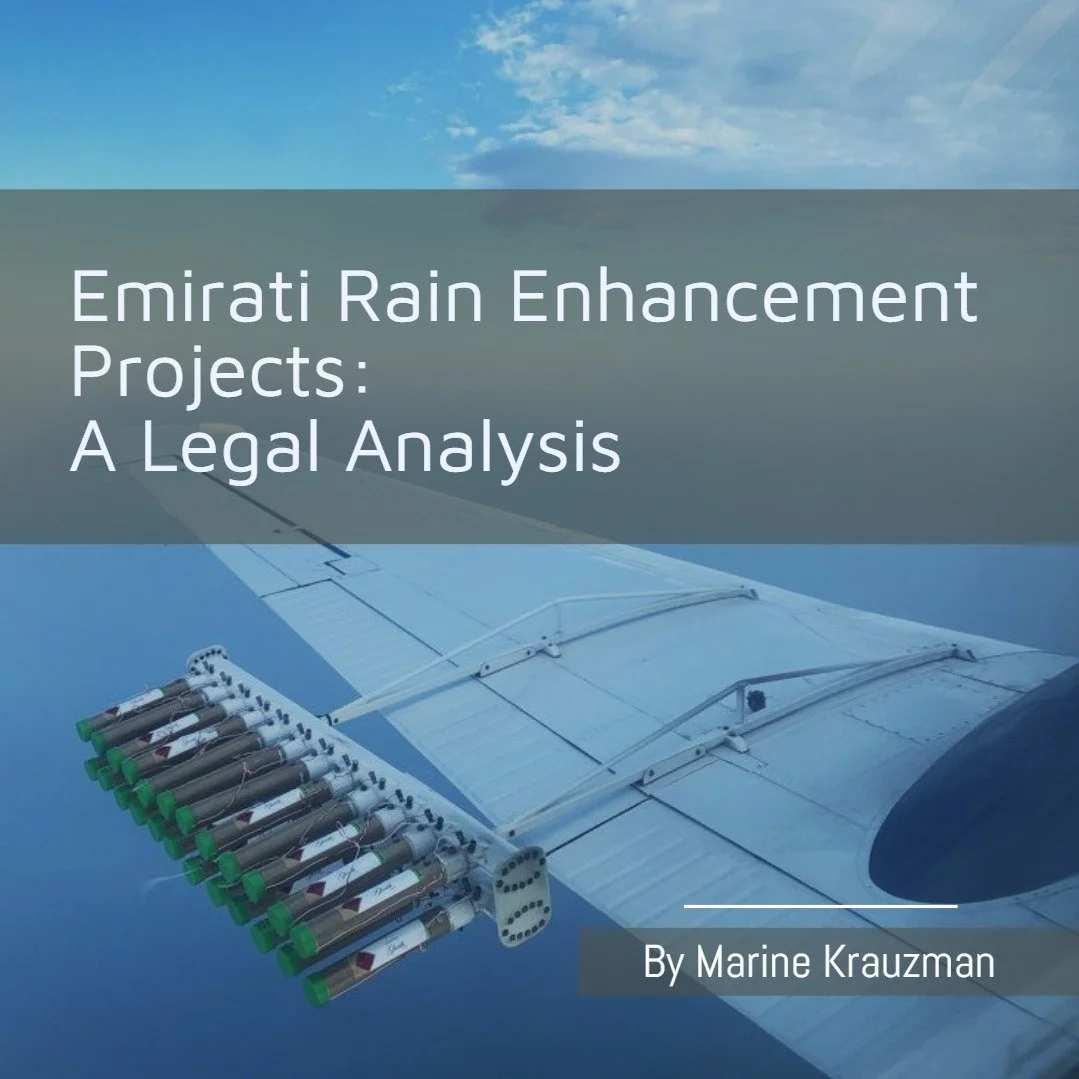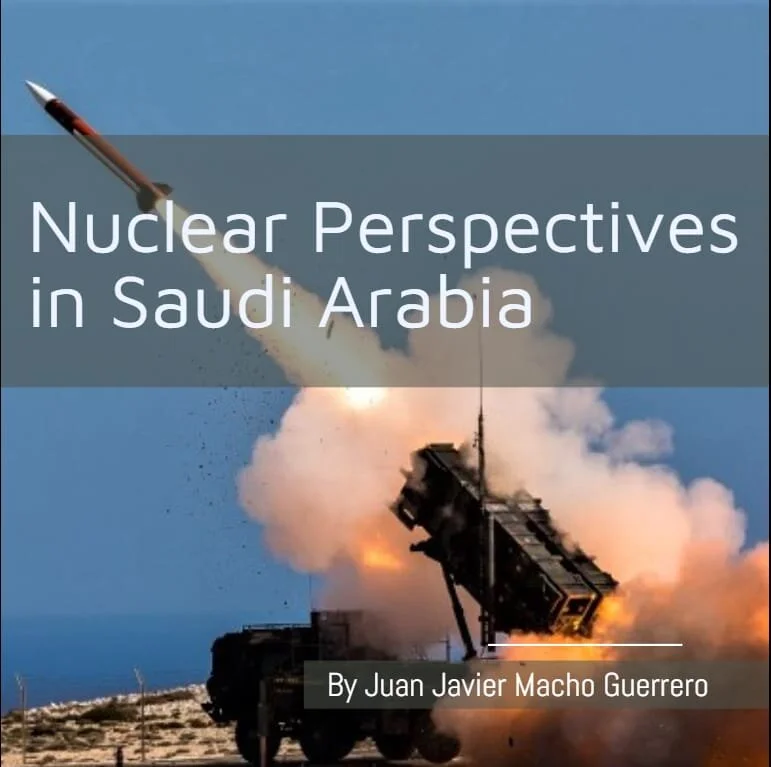The Abraham Accords, key to Donald Trump’s first-term Middle East policy, normalized relations between Israel and several Arab states. With Trump back in office, his administration aims to expand the Accords, targeting Saudi Arabia and Syria despite earlier shortcomings.
Emirati Rain Enhancement Projects: A Legal Analysis
The United Arab Emirates leads the Arabian Peninsula in the implementation of rain-enhancement techniques in a region increasingly challenged by water scarcity. Although cloud seeding is an ancient field of study, it is still poorly understood and controlled, leaving numerous questions unanswered. What are the benefits and limits of these techniques, especially regarding their militarization? To what extent does the state have a right to water contained in the clouds? This article explores the new electrical shock method of cloud seeding of the United Arab Emirates, which compensates for the limitations of older methods, and questions the international regulation of environmental modifications techniques.
Nuclear Perspectives in Saudi Arabia
Riddled with persistent conflicts, bitter rivalries and a plethora of economic, social and political fractures, the Middle East stands today as one of the most convoluted regions of the globe. As such, the international community holds a great interest in promoting effective policies to avoid the proliferation of weapons of mass destruction. The tensions coming from Iran's nuclear program have been for long a top priority in this area, but other regional actors should not be overlooked, as they may play an important role in the near future’s nuclear dynamics. This is the case of the Kingdom of Saudi Arabia, whose perspectives on nuclear technology, both for civil and military uses, will be explored in this article.
What ISIS’ Defeat in the Middle East Means for Europe: Counter-Radicalisation in the EU
Radicalisation has emerged as a sincere issue in Europe in the last five years. Since ISIS started to lose territory, foreign fighters have begun to return to Europe, while ISIS’ web presence has strengthened and increased. In response, the European Union has created some of the most successful anti-radicalisation programmes to tackle those threats. However, these measures have failed to prevent some of the worst terrorist attacks that have ever occurred on European soil. This is due to a lack of true coordination and cooperation between member states’ approaches and at the broader EU level.
by Sabbir Jubaer & Valerio Viscardi
Propaganda & Returning Fighters
As ISIS has finally been defeated on the ground, losing its entire territorial control in the Middle East [i], some observers may underestimate ISIS as a continuing and viable adversary in the future for Western countries, especially for Europe given its proximity to the Middle East. Careful observation, however, suggests that ISIS is adapting to the new circumstances through maintaining a robust presence online and by posing new security challenges. In order to address these challenges, the European Union formulated a number of policies and discussed their efficiency in addressing extremism on European soil.
Since 2013, extremist propaganda has undergone a transformation. ISIS has started to produce ‘top notch’ quality propaganda videos, with graphic details and narratives directed towards radicalisation: considered here as intolerance and a possible use of violence against democratic values.[ii] The rise of social media has further bolstered the effectiveness of ISIS’ communications, a stark contrast to al-Qaida’s communications during the previous decades.[iii] The slow destruction of ISIS’ territory and its retreat underground has ultimately been downplayed by ISIS propaganda. This has encouraged homegrown terrorist fighters to act, causing devastating harm. Recent findings suggest the increased use of encrypted communications apps (Telegram & WhatsApp) have been essential mediums for the successful distribution of ISIS propaganda.[iv]
The issue of how to deal with the returning fighters and their families has been a serious concern for European countries. Some states for instance (France and the United Kingdom), before the decision was made to withdraw American troops from Iraq, were not interested in taking back their citizens who had left to fight alongside the so-called Islamic State, fearing a further spread of militancy. In fact, different European cities had already been attacked by militants alleged to be linked with ISIS. France had argued in favour of conducting the prosecutions of the fighters in the countries where their actions took place, i.e. Iraq. However, some European countries, including France, have now agreed to take back the fighters after the United States (U.S.) announced the withdrawal of its troops, fearing the militants may otherwise escape due to the absence of U.S. forces.[v]
Another major concern is the rehabilitation of the detainees. Instead of functioning as rehabilitation centres, prisons in many European countries have emerged as new ground for radicalisation. Prisons provide a space where militants of various degrees of radicalisation can come in touch with, and influence, non-radicalised prisoners. Thus, a prisoner or a person with a lower level of radicalisation can become fully radicalised. This was suspected to be the case for the convicted burglar and prison inmate, Benjamin Herman, a white suburban teen and nominal Catholic when he was first arrested. During his detention, he came in contact with an Islamist recruiter. Whilst allowed out into the community as part of a ‘two-day home leave’ in May 2018, he murdered three people. During the investigation, the authorities found a Quran and a prayer rug in his cell. This, coupled with his link to the radicalist preacher in custody, led Europol to classify the incident as a jihadist terror attack. [vi]
Responses & Rehabilitation
To respond to these threats, the European Union created a centralised strategy for Combating Radicalisation and Recruitment to Terrorism. This strategy, revised in 2014, aims primarily at ‘combating radicalisation and recruitment while taking into account evolving trends, such as lone-actor terrorism, foreign fighters, and the use of social media by terrorists’.[vii] To this purpose, the strategy focuses on four main pillars: prevention, protection, pursuit, and response. Specifically, the prevention pillar tries to ‘prevent people from becoming radicalised … being recruited to terrorism and prevent a new generation of terrorists from emerging’ [viii]. Some examples of ongoing work in countering Islamic radicalisation are the Europol Internet Referral Unit (IRU) to combat terrorism and violent extremist propaganda, and the Radicalisation Awareness Network.
Regarding the former, on 12 March 2015, the Justice and Home Affairs Council of the European Union authorised Europol to create a special unit ‘aimed at reducing the level and impact of terrorist and violent extremist propaganda on the internet’. [ix] The IRU provides operational support to member states by identifying and referring relevant online content towards responsible internet service providers, which remove illegal content from their domain.[x] The European Union’s Radicalisation Awareness Network Internet and Social Media Working Group (RAN@) was created in 2011 by the European Council. Existing as Europe’s largest and highest funded counter-narrative campaign, it is a ‘network of frontline practitioners from across Europe who work on a daily basis with people who have already been radicalised or who are vulnerable to radicalisation’.[xi] This campaign is designed to support objectives such as implementing de-radicalisation and rehabilitation programmes, developing approaches for handling returning foreign terrorist fighters, equipping teachers and youth workers in addressing the root causes of radicalisation, and strengthening resilience, in particular among young people. Moreover, it creates synergies between different actions and policy areas of member states, enhancing the cooperation between them and the European Union.[xii]
Finally, these tools allow counter-narrative campaigns to inspire change in social structures inside each member state in order to increase integration and discourage individuals to radicalise. Each of the different thematic approaches addresses terrorist propaganda from a different angle, and none of them are comprehensive in themselves. Instead, each of these approaches have merit and, collectively, they create a stronger response to terrorist propaganda.
Counter-Radicalisation in Prison & European Countries
In order to tackle radicalisation in prison, each European country has implemented different measures. Some of the most illustrative are those of Belgium and Germany. Belgium, in 2018, developed a program known as ‘Deradex’. According to this program, radicalised inmates were kept isolated and were allowed only limited contact with other prisoners considered radicalised at the same level. The opposite approach was taken in Germany where the idea of isolating radicalised inmates was rejected favouring instead the implementation an intense monitoring and intervention program to prevent further radicalisation from occurring. [xiii] These are only two examples of the different approaches European member states have chosen. These differences are preventing the European Union, and its law-enforcement agencies, from implementing a more effective and unified action. European policy makers need to pay equal attention to homegrown extremists. The detainment and prosecution of returning fighters may give comfort for some time, however, new homegrown fighters will rise unless the root causes of extremism are addressed. Undetected radicalized European citizens can exploit their anonymity to cause more havoc and may emerge as fighters if a new front is opened.
ISIS’ future strategies
Losing territorial control in the Middle East could push ISIS to try to establish strongholds in new theatres. It has previously been successful capturing an area in a non-Muslim majority country far from its traditional area: Marawi city in the Philippines in 2017.[xiii] The group now has a presence in Libya and has declared “wilayats” (provinces/branches) in many regions around Europe. Therefore, ISIS may try to find another front near or even within European soil.
Even with an absolute lack of control over land, ISIS will continue to exist and even may thrive as long as its ideological foundation appeals to individuals. ISIS’ future strategy will likely involve attempts to evolve as a fully-fledged virtual caliphate. The cyber caliphate will engage in asymmetric warfare and provide a platform to direct its followers to organise, propagate extremist narratives, recruit new militants, and incite attacks on European soil.
In conclusion, the national approaches to tackle radicalisation in Europe have proven to be effective on a national level. However, more cooperation at a European level could empower national approach and extend their effectiveness to the whole union. The recent wave of attacks have strengthened the current European transnational cooperation and proven its necessity. At the same time, the European counter-messaging campaigns and programme provide effective support to member states, not limited to national territories, in the battle against radicalisation. However, the lack of coordination and the differences in the national commitment of addressing radicalisation undermine the general effectiveness of anti-radicalisation in Europe. Therefore, there should be more cooperation with the European law enforcement institutions in order to allow them to work as bridges between different law enforcement agencies around Europe, significantly increasing the general operational effectiveness.
Sources:
[i] The Soufan Center. 2019. “IntelBrief: A State Without Territory”. Accessed on February 12, 2019. https://thesoufancenter.org/intelbrief-a-state-without-territory/
[ii] European Commission.“Radicalization”. Immigration and Home Affair Accessed February 15, 2019. https://ec.europa.eu/home-affairs/content/radicalisation-0_en
[iii] Gambhir, Harleen K. 2014. “Dabiq: The Strategic Messaging of the Islamic State”. Institute for the Study of War.
[iv] “Counter-terrorism strategy”. European Union. 2017. Accessed February 08, 2019. https://eur-lex.europa.eu/legal-content/EN/ALL/?uri=LEGISSUM:l33275.
[v] McAuley, J. & Birnbaum, M. 2019. “France to take back ISIS fighters, reversing policy in wake of U.S. withdrawal from Syria”. Washington Post. Accessed February 12, 2019. https://wapo.st/2BxJP6K
[vi] Erickson, A. 2018. “Europe’s prisons breed terrorism. Can anything be done?”. Washington Post. Accessed March 19, 2019. https://www.washingtonpost.com/news/worldviews/wp/2018/07/26/europes-prisons-breed-terrorism-can-anything-be-done/?noredirect=on&utm_term=.51905d015a4c
[vii] “Counter-terrorism strategy”. European Union. 2017. Accessed February 08, 2019. https://eur-lex.europa.eu/legal-content/EN/ALL/?uri=LEGISSUM:l33275.
[viii] Meleagrou-Hitchens, Alexander. 2017. “The Challenges and Limitations of Online Counter-Narratives in the Fight against ISIS Recruitment in Europe and North America.” 18 (3): 95–104. doi:10.1353/gia.2017.0041.
[ix] “Europol’s Internet Referral Unit to combat terrorist and violent extremist propaganda.” 2015. News release. July 1. Accessed February 08, 2019. https://www.europol.europa.eu/newsroom/news/europol%E2%80%99s-internet-referral-unit-to-combat-terrorist-and-violent-extremist-propaganda.
[x] Dr Alastair Reed,Dr Haroro J. Ingram, Joe Whittaker. 2017. “Countering Terrorist Narratives.
[xi] European Commission. 2019. “Radicalisation Awareness Network (RAN)”. Accessed January 27, 2019. https://ec.europa.eu/home-affairs/what-we-do/networks/radicalisation_awareness_network_en.
[xii] Idem
[xiii]Betteridge-Moes, M. 2017. “What happened in Marawi?”. Aljazeera. Accessed February 12, 2019. https://www.aljazeera.com/indepth/features/2017/10/happened-marawi-171029085314348.html



